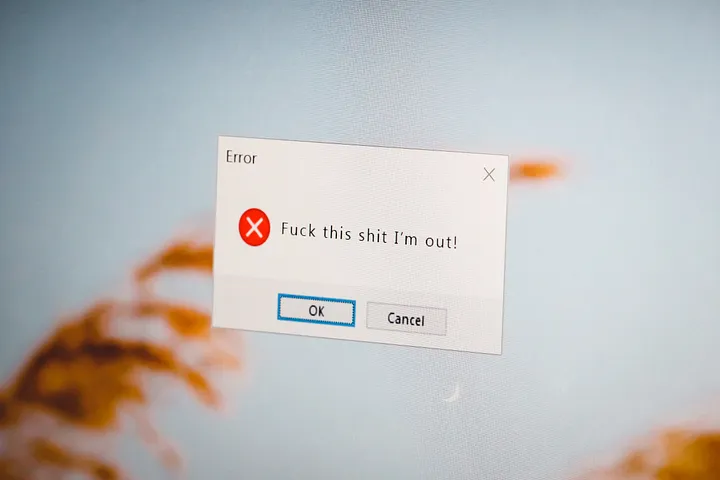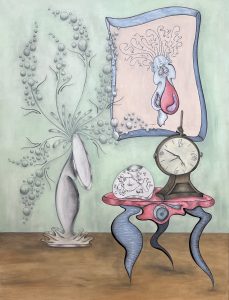The Secret to Success is Screwing the Pooch
It’s time to make a mistake. Screw up. Big.
Because making mistakes is the only path to success and life satisfaction.
I feel your resistance. Make a mistake? Ugh. No way. I get it. Screwing up. Making a terrible choice. Doing the wrong thing. Making a wrong decision. The concept triggers feelings of fear. Humiliation. Instinctively, making a mistake means:
- punishment
- others’ judgment
- loss of position
- loss of relationships
- loss of money
- embarassment
Evolutionary edicts tell us that a mistake means death. Errors mean being shunned or banished from the tribe. And then where will you be? No food. No shelter. No sexual partner.
No 401k investment account.
I get it.
But we have it all wrong.
After years of teaching, I found the thickest barrier to learning for my students was experiencing confusion. They avoided confusion like broccoli. Confusion opened the door to mistakes and failure. Confusion was the big danger elephant in the room. So, I began incorporating the following lecture into my introductory material.
Years of quality brainwashing education causes students to fear error. Mistakes mean low grades. Or worse: embarrassment among peers. Feeling dumb. Being a failure. Teacher’s disdain. So, students attempt to ascertain the answer by any means. Wait for someone to offer the right answer and parrot it. Memorize the answer provided by a peer or the teacher. Seek for the response. Cheat. Students so desperately avoid being wrong, they want to bypass the confusion and discomfort of not understanding. It’s too risky.
It looks like this:

But the only path to learn, to critical thinking, to knowledge, is through.
I tell my students:
If you knew all this subject already — if you were at the exclamation point — then you would not need to be here. You are here because you have to pass through the question mark — through the confusion and the lack of understanding.
But you are going to try to avoid that discomfort. You think confusion means you are stupid. That you will never succeed. That you are in danger. So you strive to just know the right answer. But that’s not how learning works.
Confusion means you are learning. It’s okay to make mistakes. Lots of mistakes. That’s why you are here. To make mistakes. To screw up. I will lead you through to the other side.
Remember not being able to read? Or write? Or do arithmetic? Take a minute to recall not understanding the symbols we call letters. Or not knowing what 2 times 2 equaled. You would not have learned if you had not suffered through the confusion. Consider any craft or hobby. Consider any skill. Recall not knowing how to do it. Passing through not-know is the only path to know. If you are a skilled expert, you fought through your confusion — your state of not knowing — to fully grasp and master the subject. You didn’t skip the hard part.
The fact is, confusion is required for learning and critical thinking — for applying what we learn to new scenarios. Why? Because confusion and frustration elicit deep thinking. Consider it a gift of evolution. Only those who fight through the discomfort of confusion were strong enough to survive.
The trick is to trigger enough confusion to elicit the cognitive response, but contemporaneously offer a safe and supportive environment. Confusion is good. A little stress is good. Fear and terror interfere with successful learning.
A skilled teacher knows this. He or she stimulates curiosity and guides the student into a confused state. But then, offers the student support. Compassion. And a safe space to struggle through the pain — actual pain — of confusion.
Here’s what that looks like:

Remember the subject in which you struggled and did not achieve the mastery you desired? Perhaps you (a) did not allow or avoided the confusion or (b) entered confusion in an unsafe environment. Students who prefer memorization and rote activity are the avoidant types. The confusion is too painful — too ego crushing. These students require a boost to self-esteem: You can do it. You are intelligent and competent. Allow the confusion. Understand that emotion means you are learning. That’s what learning feels like.
The students who allow the confusion but have an instructor who becomes impatient or peers who mock will feel too much danger to experience the confusion. They often resort to cheating. Or they drop the course. Or they just get by without ever understanding. They stay confused by faking it until they make it. The astute educator ensures a safe environment: confusion is to be celebrated. Mistakes are to be embraced and analyzed. Those who have resolved the confusion are encouraged to help others through: they know the map to the knowledge. They’ve traveled the path. They should be guides, not executors.
I once tutored a woman in her forties who had failed her required basic mathematics course three times. She was three credits — that one class — from her undergraduate degree. This is a woman who was so successful in her career she had won an Emmy. But for her education, she had given up. She decided she was too stupid to pass math. What a travesty. The department chair contacted me and asked me to help her. I accepted the challenge.
In our first meetings, I probed to identify what mathematical concept firstconfused her. I’d taught math for years and was familiar with where most humans freeze at the confusion gate. No surprise, I located a basic misunderstanding from her fourth-grade experience: she did not understand fractions or percentages. At all. Her teacher, too overworked or too disinterested or too unaware, had allowed her to wallow in her confusion and left her there. She had forgotten that confusion and was unaware she still did not understand. She passed the course back then. She balanced her checkbook. She advanced to fifth grade. She obviously understood enough.
But she didn’t. And she cried as I listened to her pain. Actual tears.
And then we got to work. I led her right back into that confusion. Headfirst. But I reached into that hole and helped her climb out. I helped her process her emotion. I helped her analyze her mistakes, so she resolved the confusion. I gave her a safe space to flail about.
She earned a B in the mathematics course and graduated with honors. Damn right.
“Failure is an event and not a person.” — Zig Ziglar
So, there’s our formula: confusion in a safe environment.
But, you say, more annoyed than confused, wasn’t this article about screwing up? Making mistakes? What does confusion and learning have to do with the fear of making a mistake?
Oh, grasshopper. Here we are again.
“I have not failed. I’ve just found 10,000 ways won’t work.” — Thomas Edison
Success in life requires making mistakes. Being confused. Being stressed. We do not move forward or learn or improve our lives if everything is easy. In fact, people who have it easy all the time have not mastered the skills required to conquer any challenge or overcome any barrier. Evolution will leave them behind.
I see parents blocking children from falling. You are doing your child a disservice to learn that running across a slippery floor will result in falling. But, the same principles for classroom learning apply to life lessons: confusion and mistakes must happen in a safe environment. You let the kid slip on the floor, but you don’t let him climb on the roof.
Apply the same principles to your life.
Consider your mistakes. You dated a person totally wrong for you. You experienced pain and confusion and frustration. It was awful. And you learned (I hope). You won’t date that type of person again. Or you bought a car with no research or a test drive. It guzzled gas, broke down all the time, and cost you a fortune. Lesson learned.
We don’t learn a damn thing when things go well.
I learned to cook out of necessity. For years, I had no interest. Then, I had children. I wanted to provide good nutrition. And I did not know how to do it. How did I learn? By burning the roast. I learned to time the cooking. By adding too much water to the rice, adding more rice, adding more water — How the hell is this right? I laugh now, but I cried that day. I learned the proportions are two to one. No matter if it looks soupy at first.
Each mistake led to knowledge. Each query: How do I do that? led to more information. More experience. Failure, confusion, frustration lead to enough cognitive load to learn. And passing through those mistakes had added benefits, like developing persistence and self-esteem.
Now, consider your worst mistakes — or mistakes you feel you keep repeating. Confusion you have not resolved. Using what we have discussed, ask yourself why. I guarantee you experienced your mistake, frustration, and confusion without a support system. Your fear was overwhelming, and you had no one to help you out of the darkness.
We need trusted partners, friends, and family. We need a supportive environment so life lessons do not turn into life tragedies. We need friends and family who do not shame us when we fail — they laugh with us and encourage us. We also can start creating that supportive environment by being kind to ourselves when we are confused or stressed or frustrated. Stop that internal critical dialogue. Be kind to yourself.
Try these three approaches the next time you are lost, confused, or screwing up royally.
- State: I have made a mistake. But it’s okay. I am learning.
- Ask: What went wrong? What led to this perceived failure?
- Check: What emotions are you experiencing?
- Reach out: How can you stabilize your environment so you can make mistakes?
Then, once you have those answers:
5. Investigate and analyze: What are potential solutions to this problem?
Let’s see this process in action. Bob is creating his website. He’s never made a site before and feels completely lost. He’s spent several evenings watching videos and reading tutorials and is slogging through. But he is supposed to launch his business in three days and has not even finished his landing page. He does not know what SEO is. Or how to link his page to his social media. He’s trying not to cry.
- Bob reminds himself that he is not a mistake. Mistake is not an adjective. He has made a mistake. What he is doing is not working.
- What went wrong? What led to this perceived failure? Bob admits he bit off more than he could chew — trying to learn how to create a website from scratch — and giving himself only a week to complete his task. Not a good approach.
- He admits he is confused, frustrated, and scared. He is too embarrassed to ask for help.
- Bob, first, encourages himself. He’s made mistakes before. He’s been under pressure and survived. And he can delay the launch of his business for two additional weeks. He calls his friend who created a website. The friend guides him through, step by step. The friend gives Bob several how-to resources. The friend answers his questions. Bob feels better. He’s still confused, but he’s understanding how to use the template and the plugins.
- With his friend’s support, Bob sees solutions. Little by little, he is learning. And the confusion is dissipating.
Mistakes are beautiful things. We suffer the confusion, the pain, the panic. But those emotions are the reason we come out the other side stronger and smarter.
“Failure is the opportunity to begin again, only this time more wisely.” — Henry Ford



